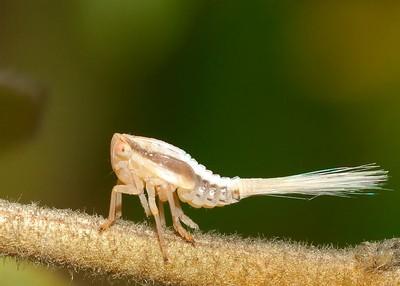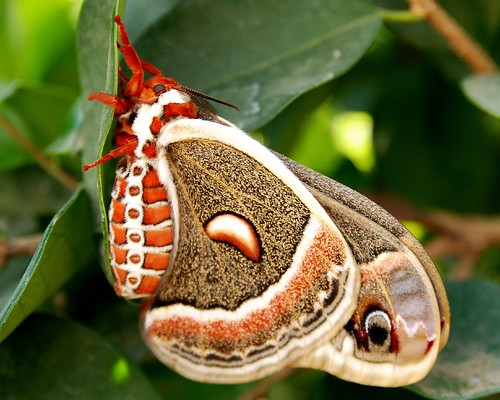amazing bugs 2
Kategori: övernaturligt
Cobalt blue tarantula
The cobalt blue tarantula (Haplopelma lividum) is a tarantula species that is native to Myanmar and Thailand.
The cobalt blue tarantula is a medium size tarantula with a leg span of approximately 13 cm (5"). The cobalt blue tarantula is noted for its iridescent blue legs and light gray prosoma and opisthosoma, the latter of which may contain darker gray chevrons.[1] Males and females look the same until the ultimate (final) molt of the males. At this point the male will exhibit sexual dimorphism in the form of a light tan or bronze coloration and legginess. Additionally males will gain embolus on the pedipalps and tibial apophysis (mating hooks). The cobalt blue tarantula is a fossorial species and spends nearly all of its time in deep burrows of its own construction.
Habitat
The cobalt blue tarantula inhabits the tropical rain forests of southeast Asia.[2] Here they construct deep burrows, and generally only leave them to find food.
Pets
The cobalt blue tarantula is a mainstay in the pet trade, however it should only be kept by experienced keepers. Being a fast and defensive tarantula with potent venom[3] means that it should not be handled, and its reclusive nature means it is rarely seen. Typical care requirements include a deep tank with 25 to 30 cm (10-12 inches) of substrate such as peat moss or coco-husk.[4] Being from a tropical region they require constant high humidity and should be provided with an open water dish. Tarantulas are generally offered 1-2 prey items (such as crickets) once weekly.
These beetles are apparently fungivores and associated with rotting wood, and as the common name implies, have one of the hardest of all arthropod exoskeletons; in some species, it is almost impossible to drive an insect pin through their bodies without using a small drill to make a hole first. When disturbed, ironclad beetles will play dead. Some species in the genus Zopherus in Mexico are decorated with costume jewelry glued to their bodies, and sold as living brooches, known as ma'kech, to be worn on one's clothes. Hymenopus coronatus (known by a variety of common names including Malaysian orchid mantis, Malaysian orchid praying mantis, pink orchid mantis and orchid mantis) is a mantis from Malaysia, Indonesian, and Sumatran rain forests. These mantises thrive in humid, warm areas of south Asian rain forests. These mantids can be found on papaya trees, orchids, or frangipani trees with flowers. In captivity, the nymph's diet can consist mainly of fruit flies, but they will eat other small insects. Adults will eat anything they can catch; this includes small lizards, bees without stingers, house flies, butterflies, moths and other non-venomous flying insects. Although primarily carnivorous, orchid mantises have been observed eating little bits of banana, this behavior is thought to balance the mantis's vitamin intake through the juices of the banana (which are rich in potassium). When threatened, the mantis either tries to confuse the predator, or scare it. If lifted into the air, they become vicious, attempting to bite everything within reach. Their predators include lizards, geckos, jumping spiders, toads, birds, rodents, bats, and shrews. This species is characterized by brilliant and beautiful coloring and unusual structure; their four walking legs resemble flower petals, and the coloration of the bodies tends to match the environment in which they were raised. H. coronatus shows some of the most pronounced sexual dimorphism of any species of mantis; the males are generally less than half the size of the females. Young nymphs resemble ants with orange and black bodies. As the mantis grows in its environment, its color comes to more closely match the coloration of its surroundings with each passing molt. It has been theorized that humidity and intensity of light play a large role in the final coloration of the adult. The woolly apple aphid is a pest for fruit growers. Many of the numerous species of woolly aphids have only one host plant species, or alternating generations on two specific hosts. In flight they have been described as looking like "flying mice", and are given nicknames like "angel flies", "fluff bugs", "Don King bugs", "fairy flies", "Frederick Douglass flies" or "fuzz-butts". Due to their whimsical appearance, some parents tell children that they carry wishes, live in tulips, and much like fairies, are born every time you make a wish on a dandelion. Hymenopus coronatus (known by a variety of common names including Malaysian orchid mantis, Malaysian orchid praying mantis, pink orchid mantis and orchid mantis) is a mantis from Malaysia, Indonesian, and Sumatran rain forests. These mantises thrive in humid, warm areas of south Asian rain forests. These mantids can be found on papaya trees, orchids, or frangipani trees with flowers. In captivity, the nymph's diet can consist mainly of fruit flies, but they will eat other small insects. Adults will eat anything they can catch; this includes small lizards, bees without stingers, house flies, butterflies, moths and other non-venomous flying insects. Although primarily carnivorous, orchid mantises have been observed eating little bits of banana, this behavior is thought to balance the mantis's vitamin intake through the juices of the banana (which are rich in potassium). When threatened, the mantis either tries to confuse the predator, or scare it. If lifted into the air, they become vicious, attempting to bite everything within reach. Their predators include lizards, geckos, jumping spiders, toads, birds, rodents, bats, and shrews. This species is characterized by brilliant and beautiful coloring and unusual structure; their four walking legs resemble flower petals, and the coloration of the bodies tends to match the environment in which they were raised. H. coronatus shows some of the most pronounced sexual dimorphism of any species of mantis; the males are generally less than half the size of the females. Young nymphs resemble ants with orange and black bodies. As the mantis grows in its environment, its color comes to more closely match the coloration of its surroundings with each passing molt. It has been theorized that humidity and intensity of light play a large role in the final coloration of the adult. The Madagascan sunset moth or simply sunset moth, Chrysiridia rhipheus, is a day-flying moth of the Uraniidae family. It is considered to be one of the most impressive and beautiful Lepidoptera.[10] Famous worldwide, it is featured in most coffee table books on the Lepidoptera and is much sought after by collectors.[11][12] It is very colourful, though the iridescent parts of the wings do not have pigment; rather the colours originate from optical interference.[7][13] Adult moths have a wingspan of 7–9 centimetres (3–3½ in). The moth was considered to be a butterfly by Dru Drury, who described it in 1773 and placed it in the genus Papilio. Jacob Hübner placed it in the moth genus Chrysiridia in 1823. Later redescriptions led to junior synonyms such as Chrysiridia madagascariensis (Lesson, 1831).[2] At first the moth was thought to be from China or Bengal,[14][15] but was later found to be endemic to Madagascar. It is found throughout the year in most parts of the island, with peak populations between March and August, and smallest numbers between October and December. Females lay about 80 eggs under the leaves of Omphalea spp. The caterpillars are whitish-yellow with black spots and red feet and are covered in club-ended black setae. Silk spun from the mouth helps the caterpillars hold onto smooth leaves and climb back to the plant when they fall. After completing four instars, the caterpillars spin an open network cocoon. The pupal stage lasts from 17 to 23 days.[16] Chrysiridia rhipheus is the sole specialist herbivore of the four species of Omphalea in Madagascar. Omphalea is toxic: the toxins are sequestered by the feeding caterpillar and retained in the pupal and adult stages.[17] Thousands of these moths migrate between the eastern and western ranges of their host plants.[
Flower crab spider


Zopherinae is a subfamily of beetles, commonly known as ironclad beetles. Together with the subfamily Usechinae they have been treated historically as a family, but have recently been joined by several additional taxa, making the Zopheridae a much larger composite family, and the Zopherinae are now only a small component within it, consisting of 7 genera in the tribe Zopherini and one genus, Phellopsis in its own tribe (Phellopsini).
Woolly Aphid
Woolly aphids (subfamily: Eriosomatinae) are sucking insects that live on plant fluids, and produces a filamentous waxy white covering which resembles cotton or wool. The adults are winged and move to new locations where they lay egg masses. The larvae often form large cottony masses on twigs, for protection from predators. They come from Japan.
Orchid mantis 

Madagascar sunset moth
Den vackraste fjärilsarten jag sett hittils.




Planthopper nymph
Red leafhopper nymph
Triangular spider
- This is a beautiful spider. We can easily find them in bushland in Brisbane, although we never saw them in our backyard. Its abdomen is triangular to heart-shaped , with white spots on its bright orange body. Its two pairs of front legs are with strong spines for capturing prey. Its two hind pairs legs are relatively small.
- Although they are in this ARANEIDAE family, which is famous in web building, they do not build webs. They only use their silk for safety lines and egg sacs.
Triangular Spiders have very small eyes and expected to have poor eye sight. They do not jump like Jumping Spiders. Instead they employ the sit and wait hunting method.
Sometimes the spider hangs itself in mid air with a few silk wires and waiting for prey.
Usually female has a larger abdomen. Triangular Spiders are sometimes found on or under green leaves, waiting for prey.
Tortoise beetle



Net-winged beetle
White apple grasshopper
Giant silk moth
(Costa rica)


Uknown insect



(unknown insects egg)







Det var allt för idag, blev rätt så mycket iaf. Och imorn ska jag försöka hinna med att skriva om strange animals. Hoppas ni gillar inläggen och om det är något ni vill att jag ska skriva om eller om ni har några ideer, eller bara vill lägga in något ni har själva skrivit så säg till :) Alltid glad över att få nya ideér och förslag och hjälp. Det här är ju som sagt en allmän blogg som förhoppningsvis ska få fler personer att öppna ögonen och se på världen annorlunda. Att få folk att undra, att börja tänka på att det finns mer än bara livet som vi har nu. Många är för upptagna av att tänka på det istället för att se sig omkring, se upp på himlen, se alla detaljer, se alla andra liv än bara människornas. Allting som lever och andas, nya saker som väntar på att få bli upptäckta, framtiden blir bara mer och mer spännande.





